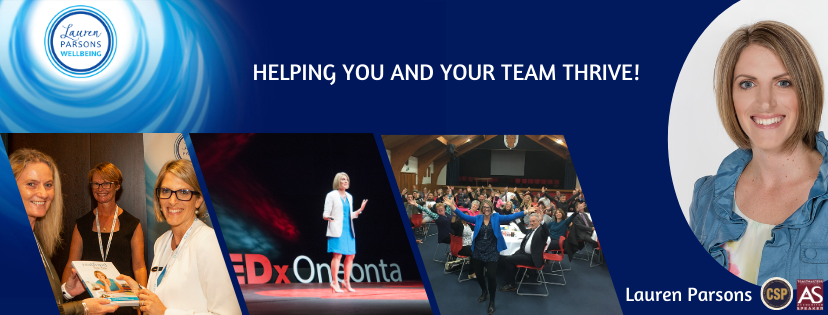An excerpt from Lauren Parsons’ book ‘Thriving Leaders Thriving Teams’.
Increasing recognition in your workplace is an incredibly cost-effective, high-impact way to lift performance, boost staff satisfaction, and prevent staff churn. The first step to make it the norm in your workplace is ensuring your leaders understand how to deliver effective praise.

Here are three keys all leaders should master:
1. FREQUENCY
Two-thirds of leaders say they give recognition at least a few times a week, but 40% of employees say they only receive recognition from any leaders in their organisation a few times a year. That’s a big disconnect.
Most employees want to be recognised a few times a month. This should be a bare minimum target. The data shows there’s no such thing as ‘too much recognition’, as long as it’s genuine and appropriately given.
Only 23% of employees strongly agree they get the right amount of recognition for the work they do, meaning nearly three-quarters are missing the steady reinforcement and appreciation they need to help them be their best.
Make a point of switching your ‘antennae’ on to catch people doing things right and give them immediate specific praise. Because of our natural negativity bias, we need to train our brain to notice when things are working well and actively seek out opportunities to acknowledge great work.
Spontaneous feedback is powerful. Take every chance you can to provide on-the-spot recognition where it’s merited. Don’t squirrel away your praise (even if it is worthy of something bigger). You can share your appreciation in the moment as well as highlighting it in the staff meeting later that month in a more formal way.
2. METHOD
While frequency of recognition is important, what’s even more vital is that it hits the mark for the recipient. Creating a fulfilling recognition experience has far more impact than just getting the frequency right. To do this well you need to know your people and more specifically, to know how they prefer to receive praise.
THE FIVE LANGUAGES OF APPRECIATION IN THE WORKPLACE
For decades, Gary Chapman’s Five Love Languages theory has transformed thousands of relationships. More recently he’s worked together with psychologist Paul White to co-author The Five Languages of Appreciation in the Workplace.
These are:
- Words of Affirmation – using words to affirm people.
- Acts of Service – actions speak louder than words.
- Tangible Gifts – people like tangible things to feel appreciated.
- Quality time – giving someone your undivided attention.
- Physical Touch – appropriate touch, such as high fives, pats on the back. (In the workplace, this is less important than the other four.)

The challenge is we all naturally (unconsciously) offer praise and appreciation in ways that we most like to receive it. This is where the ‘platinum rule’ comes in again. As I outlined in Chapter 13, treating others as they want to be treated is better than gold.
If you understand what motivates each of your team members, you can tailor your appreciation to what works for them.
- Giving a gift without a card to someone who really appreciates words of affirmation will leave them wanting more.
- Writing a fantastic message to a colleague who’d prefer some practical assistance will leave them disillusioned.
- Covering part of someone’s shift and sending them home early will fall flat, when they’d really prefer a catered afternoon tea to spend quality time with their colleagues.
3. MEDIUM
Even if you know what someone’s preferred language of appreciation is, you also need to identify the best medium. For example, that staff member who values words of appreciation, do they want to receive them in a handwritten card, an official certificate or an email copying in their boss?
Common ways people prefer recognition include:
- Public recognition – in person, at a formal event, a plaque on the wall, or a staff-wide email
- Private recognition – in person, in writing, by email, in a card, or a post-it note on their desk
- Tangible recognition – an award, certificate, gift or bonus
- Benefits – extra time off, improved flexibility, a nicer desk or workspace
- Job-specific recognition – extra responsibility, leading the next project or a promotion
One in four people prefer only private recognition, while the majority of others like a mixture of both public and private praise. It’s important not to assume you know what meaningful feedback looks like.
In your one-on-ones pose questions like:
- What’s the best recognition you’ve ever received?
- What sort of recognition doesn’t appeal to you?
- What does meaningful recognition look like / sound like / feel like to you?
- Do you value trophies, certificates or awards?
- Do you enjoy surprises?
- If you love public recognition, would you rather it was announced at a staff meeting or via a group email update?
- Do you value praise from your manager or your colleagues more?
Understanding people’s preference for public vs private recognition is key. If I call Jenny up in the full staff meeting to give her a surprise award when she hates being the centre of attention, she’ll dislike the experience immensely. Conversely, if Mark prefers public recognition and I pull him aside and give him an envelope on the quiet, he’ll feel that I didn’t really mean it because I didn’t present it in front of his peers.

The benefits of public praise are that it helps reinforce your culture of recognition, seeing as it’s more visible. The more you make it a norm in your workplace, the more you can encourage even shy team members to feel comfortable with it. Just always respect their feelings and minimise awkwardness.
Introverts can still enjoy their work being publicly recognised – they just may not wish to be made a spectacle of. For example, you might gift Jenny flowers and a card one-on-one, or at a very small team meeting, then put a photo of it up on the staff noticeboard, rather than making her come up front in an all-hands meeting. This way she still receives meaningful recognition which others can witness and celebrate, but she’s not put on the spot.
What steps will you take to improve the way you deliver recognition?
Enjoyed this article?
If you’d like to improve staff wellbeing at your workplace feel free to download a copy of my eBook 5 Keys to a Positive, Energised, High-Performance Culture here.

About the Author – Lauren Parsons, CSP, AS
Lauren Parsons is a sought-after international speaker, author, and expert in resilience, wellbeing, and leadership. She’s passionate about equipping busy professionals with powerful strategies to enhance energy, vitality and performance.
Named NZ Keynote Speaker of the Year and Educator of the Year for 2023/24 by the Professional Speakers Association, Lauren is one of only a handful of Certified Speaking Professionals and the only Toastmasters International Accredited Speaker in New Zealand. With over 20 years of experience, she’s a TEDx speaker, author of Thriving Leaders Thriving Teams, and host of the Thrive TV Show.
Lauren blends her expertise in wellness, business, and leadership to be the only speaker worldwide focusing on the intersection of boosting both wellbeing and productivity. Described as dynamic, life-changing, and unforgettable, Lauren’s presentations leave audiences inspired, uplifted, and ready to take immediate action.
Based in the Manawatu, New Zealand, Lauren lives with her husband, three children and a menagerie of animals. She travels regularly to speak at conferences and in-house, helping leaders create positive, energised workplaces, where people thrive.
See all the goodness at Lauren’s “Free Stuff” page – www.LaurenParsonsWellbeing.com

Ways to connect with Lauren
- Find out about conference keynotes
- See her most popular topics
- Make a time for a virtual cuppa over zoom
Share this Post
